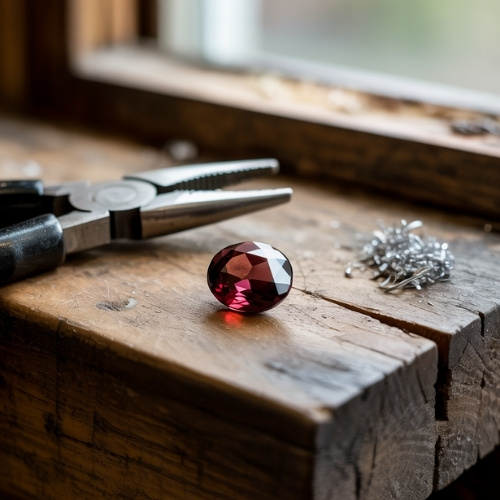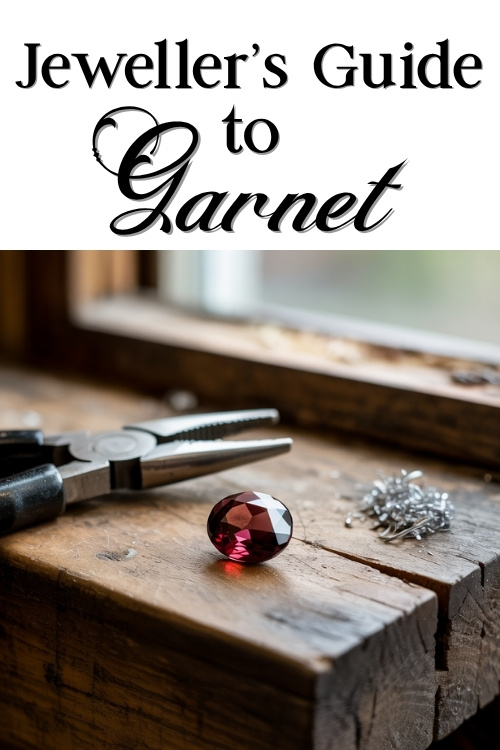Rich, radiant, and full of character, garnet is far more than the deep red gem many picture. This timeless stone has adorned jewellery for thousands of years, but behind its history lies a fascinating world of colour, structure, and variety.
Unlike most gemstones, garnet isn’t a single mineral, but a closely related group. Every garnet crystal is a blend of at least two types, with the dominant species defining its variety. From fiery oranges to lush greens, garnet offers jewellers a versatile palette, grounded in tradition yet full of surprises.
Basic Identification Information
Name & Synonyms
Garnet (see table at the end of this guide for variety names)
Species
Garnet group – a family of closely related minerals rather than a single species
Colour Range
Best known for red hues, but garnet also appears in orange, yellow, green, pink, purple, brown, black, and even colourless.
Colour-change and star garnets are rare but notable varieties.
Refractive Index
1.720 – 1.895
(see table at end of each types RI range)
Birefringence
None as singly refractive
Optical Sign
SR (singly refractive)
Pleochroism
Not applicable as this only occurs in doubly refractive gemstones
Specific Gravity
3.15 – 4.30
Fluorescence
Usually inert, though rare weak reactions may occur
Lustre
Vitreous (glass like) to subadamantine (almost diamond like)
Clarity
Type II
While eye clean examples do exist, garnets are generally expected to have some visible inclusions.
Gems Often Mistaken For
Ruby, Spinel, Tourmaline
Mohs Hardness
6.5 – 7.5 depending on the variety
Wearability
Good to excellent. Suitable for most jewellery types, including rings and bracelets.
Birthstone
January
Spotting Synthetic (Lab-Grown) Garnet
While synthetic garnets such as yttrium aluminium garnet (YAG) and gadolinium gallium garnet (GGG) exist, they are typically used as diamond simulants or for industrial purposes. These synthetics are often flawless, unusually bright, colourless, and may show diagnostic differences under magnification or with a refractometer.
Common Treatments
One of garnet’s greatest advantages is its lack of routine treatment. Most garnets are sold just as they are mined, unheated and unenhanced. This can be a compelling point for customers seeking a completely natural gem.
Durability & Setting Considerations
Garnet’s hardness range (6.5 to 7.5) means it’s durable enough for everyday wear, especially in earrings, pendants, and protected ring settings. While it lacks cleavage, making it less likely to split when struck, garnet can still be scratched by harder materials.
Stones on the softer or more included side benefit from extra setting protection. Bezel settings are ideal for durability, while prongs can showcase cleaner, larger stones beautifully.
Soldering near a set garnet should be avoided when possible, as excessive heat may cause surface damage.
Care Instructions
Cleaning
Use warm soapy water and a soft brush. Avoid ultrasonic and steam cleaners, especially for included stones.
Storage
Store separately from harder gemstones such as sapphire, spinel, or topaz to avoid surface scratches.
Daily Wear
Most garnets perform well under regular wear. Remove rings before activities that could expose the gem to hard knocks or abrasives.
Market & Ethical Notes
Garnet is found around the world, with major sources including India, Sri Lanka, Madagascar, Kenya, Tanzania, Namibia, Russia, and the United States.
Because it’s widely available, garnet often comes from small-scale or artisanal mining operations. Ethical sourcing practices can vary, especially across African deposits. Premium garnets like tsavorite and demantoid are more likely to carry traceable sourcing certifications and may command higher prices as a result.
Symbolic & Spiritual Meanings
Garnet has long been associated with protection, passion, and vitality. Historically, it was worn by travellers as a talisman for safe journeys and against danger.
In modern crystal healing, garnet is said to enhance courage, confidence, and creative energy. It’s often used to support emotional strength and spark motivation.
Red garnets are strongly linked to the root chakra, making them popular for grounding rituals and energetic balance.
🔗 Dive deeper into Garnet’s Symbolic & Spiritual Meanings
Etymology
The name garnet comes from the Latin granatus, meaning “seedlike.” It refers to the gem’s resemblance to the vibrant red seeds of a pomegranate, a fitting image for such a rich and enduring stone.
🔗Curious about how garnet was viewed in ancient cultures? Explore its fascinating myths and legends (coming soon)
Garnet Varieties
As mentioned above, Garnet isn’t a single gem, but a group of closely related minerals. Here’s a breakdown of the various types you might encounter or hear about, including RI ranges for accurate identification and the colours you can expect to find them in:
| Type | RI Range | Colour Range |
| Almandine – Most common type | 1.760 – 1.820 | Red (inc. purplish, orangey, and brownish), brownish Black |
| Andradite | 1.855 – 1.895 | Green (inc. yellowish, and brownish), Yellow (inc. orangey, and greenish), Brown (inc. orangey, and greenish), Black (inc. greyish) |
| -Demantoid (Andradite subtype) | 1.855 – 1.895 | Green to yellowish Green (often with yellowish-brown horsetail inclusions) |
| -Melanite (Andradite subtype) | 1.855 – 1.895 | Opaque Black |
| -Topazolite (Andradite subtype) | 1.855 – 1.895 | Yellow |
| Grossular | 1.730 – 1.760 | Pink, Yellow (inc. greenish), Green (inc.yellowish), Orange, and Colourless (rare) |
| -Hessonite (Grossular subtype) | 1.730 – 1.760 | Orange (inc. yellowish, reddish), orangey Yellow |
| -Hydrogrossular (Grossular subtype) | 1.730 – 1.760 | Green (inc. bluish), Pink, White, Grey. (Transulcent to Opaque) |
| -Tsavorite (Grossular subtype) | 1.730 – 1.760 | Green (inc. yellowish, bluish) – needs to have a strong vivid colour |
| Pyrope | 1.720 – 1.756 | Red (inc. purplish, orangey, pinkish), reddish Orange, Colourless (very rare) |
| Spessartite | 1.790 – 1.814 | Orange (inc. yellowish, reddish), Red, Brown (inc. reddish, yellowish, orangy), Yellow (inc. brownish) |
| -Mandarin (Spessartite subtype) | 1.790 – 1.814 | bright Orange, reddish Orange |
| Uvarovite | 1.740 – 1.870 | Green (Translucent to Opaque. Usually not cut for jewellery due to very small crystal sizes) |
| Malaia (Pyrope–Spessartite blend) | 1.742 – 1.780 | Pink, Orange (inc. yellowish, reddish, and pinkish), Peach |
| Mali (Grossular–Andradite blend) | 1.760 – 1.780 | Green (inc. yellowish), Yellow (inc. greenish, and brownish), Brown |
| Rhodolite (Pyrope–Almandine blend) | 1.740 – 1.770 | purplish Red through to reddish Purple |
| Colour-Change Garnet (Pyrope–Spessartite blend) | 1.742 – 1.780 | Greenish or brownish Green (daylight). purplish Red, reddish Purple, or raspberry pink (incandescent light). Beige (daylight) to Pink (incandescent light). grayish Green (daylight) to purplish Red (incandescent light) Blue-Green (daylight) to Purple (incandescent light). |
| Star Garnet – usually 4 ponted star but can have 6 points | 1.760 – 1.820 | Red (inc. purplish), Purple (inc. reddish) – very dark in colour |
📌 Save this jeweller’s guide to garnet for quick reference next time you’re working with this stunning gem.


